"Mary Poppins" written by P.L. Travers
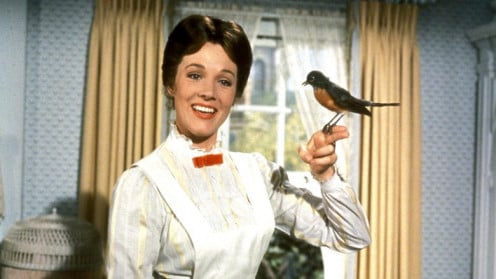
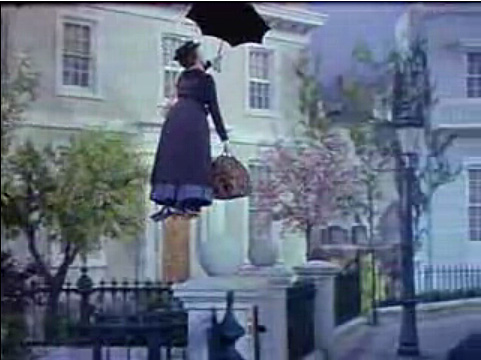
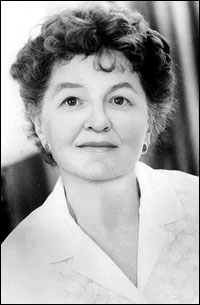
P. L. Travers' Mary Poppins series
Mary Poppins 1934
Mary Poppins Comes Back 1935
Mary Poppins Opens the Door 1943
Mary Poppins in the Park 1952
Mary Poppins From A to Z 1962
Mary Poppins in the Kitchen 1975
Mary Poppins in Cherry Tree Lane 1982
Mary Poppins and the House Next Door 1988
Have you read the Mary Poppins novels or seen the film?
Who can forget the beloved Walt Disney film, Mary Poppins (1964) with the umbrella flying nanny who pops in and out of the Banks family's lives? Or of the lovely Julie Andrews playing the friendly, loving and gentle nanny to the Banks' children?
She was the magical nanny that was always cheerily giving us our medicine, "With a Spoonful of Sugar", and inventing new worlds and words like "Supercalifragilisticexpialidocious" for all of our delight? We fell in love with her and we all wanted Mary Poppins as a nanny in our own family.
Or, who can forget the lovable Bert, the chimney sweep, that squires Mary Poppins and the children around London and jumps into the worlds of his chalk drawings?
This year is the 50th anniversary of that wonderful and charming movie brought to us by Walt Disney. But, where did Walt Disney get the idea for the movie?
His own daughter, Diane, brought the character of Mary Poppins to his attention through the book she had read by P. L. Travers. And as early as 1938, Disney embarked on a charming offensive to get Travers to sell the Mary Poppins character to his Disney studios. He did not succeed until 1961.
I, for one had never heard of P. L. Travers or her inventive character Mary Poppins, who is a magical, mystical nanny who pops in and fixes things, until the film came out in l964. She comes floating in on her umbrella with the east wind and stays "until the wind changes."
But, Travers had created a character that had been popular, beloved and famous to British and English children for many years. Travers instinctively and quickly wrote the first book in 1934, not even realizing herself at the time, that her creation of Mary Poppins was the result of her own unhappy childhood. The series grew to eight books about Mary Poppins before Travers died at 96 years of age in 1996.
She has been quoted as saying in interviews, "I never wrote my books especially for children. We have no idea where childhood ends and maturity begins. I just write for myself." But, she was always thrilled that children loved her series of books.
Travers wrote her original book, Mary Poppins (1934), at the end of a groundbreaking era of children's literature in England. She followed in the footsteps of such famous children's book authors as Lewis Carroll (Alice in Wonderland), J. M. Barrie (Peter Pan), and A. A. Milne (Winnie-the-Pooh).
Travers' Mary Poppins, however is quite different than the Disney film version of the book. Her book is set in the Depression-Era London of the 1930s and describes a Great Empire in decline. The Banks family is middle-class, but with financial problems. It is a much darker, satirical and mystical novel than the film.
Travers seemed to be rewriting her sad and lonely childhood as she weaved the tale of her character Mary Poppins and her fantastic adventures. As a child growing up in Australia, Travers' own father was a bank clerk who died of alcoholism when she was seven years old. She based the character of Mr. Banks in her novel on her own father.
Her mother tried to commit suicide, but failed, shortly after her of abandonment haunted her for the rest of her life. And, so these ideas became her themes in her Mary Poppins series.
Travers' character of Mary Poppins is often "vain, angry, threatening, scornful and frightening." Not at all like the film version of the kind, gentle, and loving Mary Poppins. But, her Mary Poppins was definitely magical. She took her charges on fanciful adventures and magical delights in Travers' novel. And that is why the Banks children loved her so much.
The novel is not so much about the children as it is the adults, Mr. and Mrs. Banks, whom Mary Poppins must show and convince to become better parents to their children by spending time with them rather than avoiding them. The Banks' don't need a nanny, they just need to spend more time parenting and loving their own children.
During WWII, Travers lived and worked in Manhattan for the British Ministry of Information and was homesick for England and her friends so much that she sought out the professional advice of a psychologist. The psychologist's final analysis to her was this, "You don't really need me. All you need to do is read your own books."
Travers took her advice and re-read her Mary Poppins novels and realized that Mary Poppins was her. Mary Poppins was in her blood and instinctively had risen to the surface as the Mary Poppins character for her novels.
It was also when she was living in Manhattan that Roy Disney contacted her about selling the Mary Poppins character to Disney Studios. Traver's declined.
She wrote the novels illustrating the great truths to children that "nothing lasts forever" and "all good things come to an end."
Mary Poppins leaves the Banks family as abruptly as she came when her work is finished and she is no longer needed. The Banks have learned to spend time and energy with their own children .
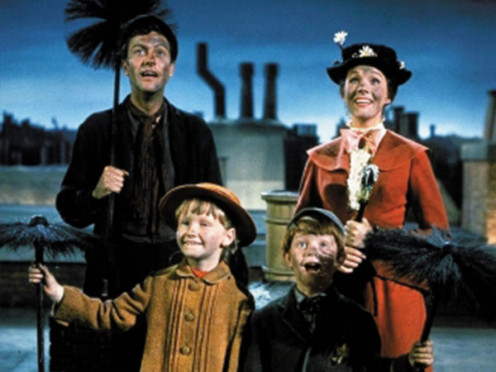
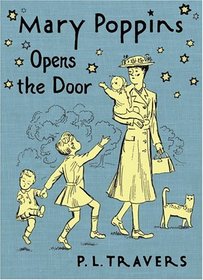
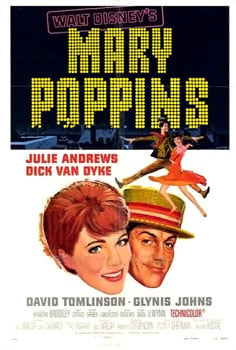
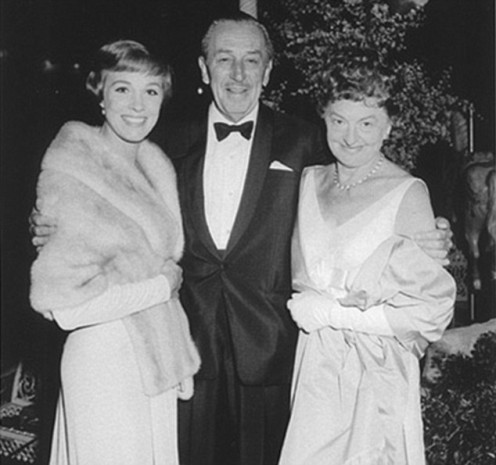
Best Song Oscar went to "Chim Chim Cheree" 1964
Pamela Lyndon Travers was born Helen Lyndon Goff in Maryborough, Queensland, Australia in 1889, and did suffer a very unhappy childhood. Many times, as the eldest child, she was left in charge of her younger siblings and Mary Poppins was the name of a character she made up for the childhood stories she would tell the younger children to keep them entertained and occupied during her mother's long absences from the family.
When she was a teenager, she escaped her unhappy home to become an actress on the stage and performed and toured Australia and New Zealand in a Shakespearean company. She also worked as a journalist and began writing poetry at this time. Her pen name was P. L. Travers and she took this as her name when in 1924 she immigrated to England to pursue a writing career.
In 1933, she began writing her series of novels about the magical English nanny, Mary Poppins. She greatly admired the writer J.M. Barrie, the author of Peter Pan, and there are many structural resemblances from that novel in her Mary Poppins novels.
Mary Sheppard was her illustrator for all eight Mary Poppins novels.
Only the first three books feature Mary Poppins arriving and leaving the family. The last five books give previous unrecorded adventures of Mary Poppins from the first three books.
Mary Poppins was published in London in 1934 and it was her first literary success. Also, during this time she continued writing poetry and met and knew both William Butler Yeats and George Russell. She initiated the meeting with both writers and became lifelong friends with both of them.
After WWII, and with the success and popularity of her children's novels, she became writer in residence at Radcliffe Hall, Harvard University and Smith Hall.
At the age of 40, Travers decided to become a single mother and adopted a baby boy from Ireland. The odd circumstances of the adoption were that the baby boy was a twin, however, she did not want to adopt the other boy, the twin. Neither boy ever knew about the other until they became adults and the other twin showed up on Travers' doorstep one day. She took much press criticism for the choices she had made in this adoption situation.
By 1961, her book sales were declining so she finally succumbed to Disney's charm and met with Walt Disney about bringing her original novel to film. She was quite outspoken, saavy and shrewd in her negotiations with Disney.
She negotiated a lump sum payout of $100,000, five percent of the movie gross and script approval, which was unheard of at the time. However Disney retained final say on the finished print of the film. The Disney film made her a rich woman and a world-wide famous author, something she of which she had always dreamed.
Travers nearly drove Walt Disney 'mad' with her her demands and that the film remain as she wrote it originally in the novel . We all know from experience that usually the novel is better than the film adaption. And Travers was adamant that the film character of Mary Poppins remain the same as in her novel. She even demanded that the color red be totally eliminated from the film.
All her demands did not last long. Disney convinced her that for audiences, especially American audiences, who were not familiar with nannies to begin with, the character of Mary Poppins needed to be likable and "almost perfect in every way." Also, there had to be a number of changes from the book to the film to fit the story into a two hour film. She absolutely told Disney the film could not be animated, although Disney put in a small animated section in the movie.
Some of the best satirical and mysterious aspects of the book had to go so that the Disney film had a cheerful and positive tone. Therefore, the film character of Mary Poppins had to become less vain, nasty, cold and intimidating than the book character of Mary Poppins and this was a difficult pill for Travers to swallow. Naturally, she wanted the film adaption of her novel as close as she had written it.
Disney also wanted to create a love relationship between the characters Mary Poppins and Bert, but Travers demanded that Bert and Mary Poppins' relationship remain platonic as it was in the books.
The Sherman Brothers were brought in to write the wonderful songs for the film. That Mr. Banks was emotionally absent from the family became the narrative arc for the film and Mrs. Banks became a 'working mother' as she works in the Women's Suffragette movement for the women's vote. She is so busy with this that she does not have time for the children.
Also the setting of the film was changed from Depression Era 1930s London to Edwardian Period London. Travers finally but reluctantly agreed to the script but when she saw the completed film for the first time at the premiere, she was shocked.
She hated the animation in the film and greatly disliked the Disney adaption of her novel and never agreed to another Disney adaption of the remaining seven Mary Poppins novels.
Later in her life, just a few years before she died, she made a final attempt to control her legacy. She sold the theatrical rights of Mary Poppins to producer Cameron Mackintosh and he has created a stage production of Mary Poppins as the character as Travers wrote her. It will be coming to Broadway next year.
Next month, the movie, Saving Mr. Banks, is coming out starring Tom Hanks as Walt Disney and Emma Thompson as P.L. Travers which portrays the two sparing over the adaption of the novel to film in 1964.
Sources: www.newyorker.com and www.parisreview.com

- Walt Disney - the genius creator of Mickey Mouse
M-I-C-K-E-Y M-O-U-S-E! If you are an original Mouskeeter, you will remember that song! Walt Disney and his loveable Mickey Mouse are two of America's most loveable "characters."
The film "Saving Mr. Banks"
December 2013
I just saw the film, Saving Mr. Banks, which is the story of P.L. Travers and Walt Disney going head to head on bringing Traver's first Mary Poppins book to the screen as the film of 1964. Yes, they had a testy relationship to say the least, but the story is so engaging and interesting that it is just as interesting and entertaining as the film itself, Mary Poppins.
I enjoyed the film immensely and found the conundrum between Disney and Travers quite a steel of nerves between the two of them. I could understand both sides of their disagreement. Travers wanted the integrity of her nanny character, Mary Poppins to remain as she originally wrote it. And, her Mary Poppins was not the sugary sweet concoction of a character that Disney dreamed up for his version of his film.
Travers' Mary Poppins was a no nonsense practical nanny who encouraged the children to help around the house and keep things 'ship shape,' but also took the children on magical mystery tours during their leisurely time, and yes, she was definitely an umbrella flying nanny with a talking parrot handle on her umbrella.
Disney wanted to make the film a musical with music, songs and nanny adventures that would never be forgotten by the audience.
I could understand both sides of this disagreement, both Travers wanting the character to remain as she had originally written it, and Disney wanting to turn the story into a musical film, with a sequence of animation, and songs that to this day we would all remember. "Just a Spoonful of Sugar," is my favorite song from the film to this day.
I have always admired and loved Walt Disney because of his creative genius in capturing the imagination of children in his animation, his films, and his Disneyland (CA) and Disney World (FL). So I could understand his wanting to change the original character around especially for American audiences.
I can certainly understand Travers not wanting her character and book turned into animation or a 'cartoon' as she so apply said many times. I could understand her horror at the animation sequence in the final version of the film.
I thought the cast of characters were great. Who else but Tom Hanks as Walt Disney? Emma Thompson as P.L. Travers was outstanding. The Sherman brothers who wrote the songs for the film were wonderful.
I enjoyed the Australia flashback scenes of Travers' childhood and found them extremely helpful in explaining where Travers was coming from when she wrote her series of Mary Poppins books.
Many times, there is a small kernel of truth in the writing of great literature. And seeing and understanding Travers' childhood and relationship with her father helped the audience to understand Travers as a person, her 'spit spot' attitude towards life, and her reason for fighting so hard to maintain the integrity of her character and book.
I enjoyed the Australian flashbacks even though critics have felt they cut up the film too much, I did not get that feeling viewing the film at all. Colin Farrell's Australian accent has been criticized as not being well done, but not being an expert on Australian accents, I saw nothing wrong with his accent.
I was touched by Walt Disney at the end of the film when he arrives at Travers' English home the day after her arrival home. He is understanding and warm and he finally shows he understands her and her feelings. He realizes at the end that writing is not an easy task and does many times contain a kernel of truth to it. He finally understands that Travers herself so closely identifies with her Mary Poppins character, that it was excrutiatingly difficult to sign over the rights to Mary Poppins.
Walt - he only used first names at the Disney Studios - brought tears to my eyes as he made his final speech to get Travers to change her mind and give her rights of the character to him so the film could be made.
This was an endearing story and film and Mary Poppins is not complete without seeing this film also. I also enjoyed the extra when the credits were rolling and we were able to hear the actual tapes of the sessions of Travers with the Disney people going over the script for her approval.
Travers had insisted that all script sessions be taped and I think she was quite smart to insist on that. Her words could not be twisted or any 'misunderstandings' occur.
This is a delightful film about two people of divergent opinions and ideas for a film coming together and working together to make a creative, imaginative and engaging Mary Poppins film that is one of the best Disney films made.
Note: A new Mary Poppins has been selected for a remake of the original movie and that is Emily Blunt who I think will be wonderful. I don't know the release date because I don't think filming has started. But, I look forward to Blunt's performance and her specific take on the character. More about it here when it comes out.









